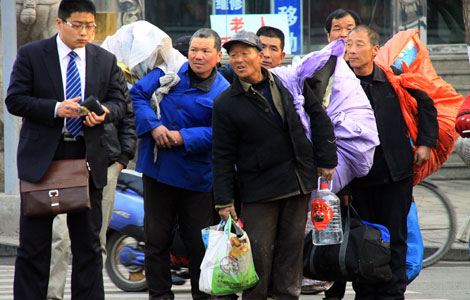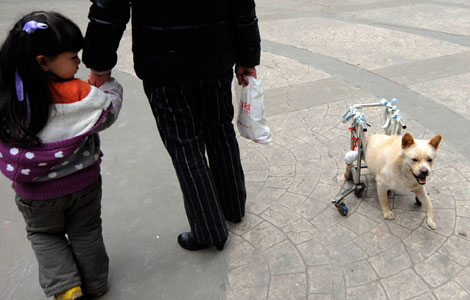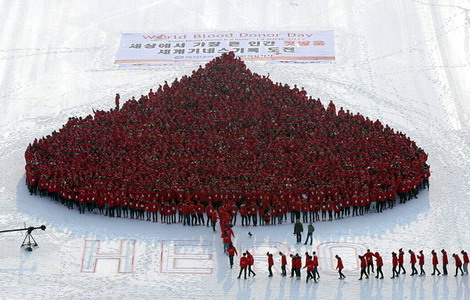A tale of two bases for pandas
Updated: 2012-02-25 09:29
By Liu Xiangrui and Huang Zhiling (China Daily)
|
|||||||||||
YA'AN, Sichuan - Tan Chengbin has just entered into what are likely to be his busiest days at work during the entire year.
 |
|
Pandas eat bamboo at the China Conservation and Research Center for the Giant Panda's Bifengxia Base in Ya'an, Sichuan province, on Tuesday. [Photo by Jiang Dong / China Daily] |
Even with seven years of experience as a panda keeper, he is as nervous as he is happy about the approach of the annual mating season for giant pandas.
"Panda matings and births are big things for me," said Tan, who works at the Bifengxia Base under the China Conservation and Research Center for the Giant Panda in Ya'an, Sichuan province.
"I have to get everything prepared in advance."
After a deadly earthquake hit Sichuan in 2008, more than 50 artificially bred panda cubs have been born at the center.
The Bifengxia Base, which has become the biggest breeding center for pandas in the world, plays an essential role in efforts to conserve the rare species.
"It became an emergency shelter for the pandas after Wolong Base (another conservation center) was ruined in the quake," said Huang Yan, vice-chief engineer of the center.
The devastating earthquake cut off the power supply, communications and traffic to the Wolong Base. Afterward, two pandas were missing, and one of them was later found dead.
The center moved its personnel and pandas out of the center, and later transferred more than 50 pandas to the Bifengxia Base.
Tan was one of the keepers who left with the pandas from Wolong. He still clearly remembers the earthquake.
"I had no idea what was happening," said Tan, who was then on duty at the Wolong Base. "I saw rocks rolling down from the mountains and a bunch of dust."
After fleeing to open ground, he calmed down and then ran to check on a panda named Qingqing, which was then only 1.5 years old.
A wooden house where Qingqing had been kept was destroyed and half buried by rocks. Its door was blocked. Tan used a rock to break into it.
"She (Qingqing) was very nervous," Tan recalled. "She climbed up to the roof through an iron fence. I had difficulty getting her because she kept moving and scratching, and there were aftershocks."
With the help of his colleagues outside, Tan rescued Qingqing. Despite the safe escape, the panda, which now lives in the Bifengxia Base, still "gets nervous easily, and will climb up high when there is a noise", Tan said.
The huge 2008 earthquake has had noticeable effects on Qingqing and other panda survivors. Some have displayed behavioral disorders or a lack of appetite or are easily frightened.
"However, most of them recovered some time after the disaster," Tan said. "We have used all kinds of methods to help the traumatized pandas recover."
Tan said he and other keepers would stay for long hours with the pandas, feed them by hand and talk to them to develop a bond of trust.
"They are really smart," said Tan. "It's really like we are friends."
Since the Bifengxia and Wolong bases differ greatly in altitude and climate, caretakers there have to help the pandas adapt to different environments.
The Bifengxia base was built in the 1990s and it was designed to maintain only 18 giant pandas when it was put into use in 2003.
The government then spent 10 million yuan ($1.59 million) to improve it. Within the three months following the quake, about 18 temporary staff shelters and more than 20 breeding enclosures were built.
The base now has more than 80 pandas, including six pandas that returned from overseas. Tan will monitor the pandas closely and pay attention to any changes they show in their shapes, weights, appetites and behaviors. He will also prepare food for them and clean and check their shelters.
In the latter half of the year, the moved pandas will return to their home in Wolong, where a new base has been built.
"This year will mark the homecoming of the giant pandas," said Huang.
Besides taking the giant pandas back to Wolong, the center will let an artificially bred panda go free in the wild in October - the first time that has been done.
"Helping them return to the wild will be our ultimate goal, because the wild is pandas' real home," he said.
The center began holding training programs in 2010. Those usually last two years, starting from when cubs are born.
In the future, the center will give its three chief bases different roles in protecting the giant pandas, Huang said.
The new Wolong base will concentrate on artificial breeding, while the Bifengxia Base will be devoted to science education and rescuing injured and old wild pandas. The base in Dujiangyan, meanwhile, will conduct research into the control and prevention of diseases.
China Daily
Related Stories
Giant pandas start new life in France 2012-01-16 06:48
Two giant pandas from China land in Britain 2011-12-04 17:04
Giant pandas find new home 2011-04-28 13:33
Pandas to be set free in protected area 2011-12-21 20:38
Pandas don't grow on trees 2012-02-20 15:39
Hot Topics
Wu Ying, iPad, Jeremy Lin, Valentine's Day, Real Name, Whitney Houston, Syria,Iranian issue, Sanyan tourism, Giving birth in Hong Kong, Cadmium spill, housing policy
Editor's Picks

|

|

|

|

|

|







